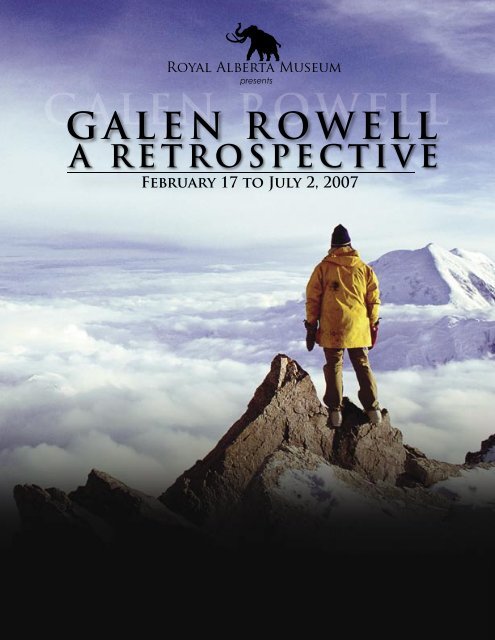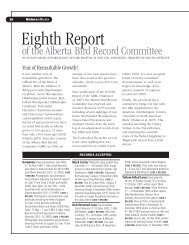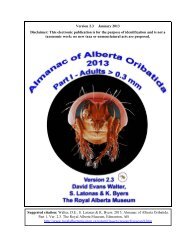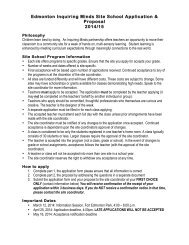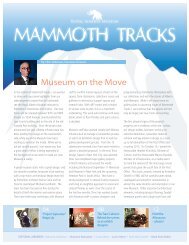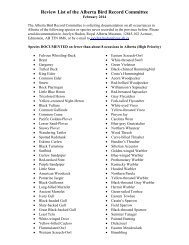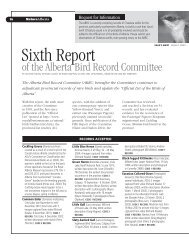galen rowell a retrospective - Royal Alberta Museum
galen rowell a retrospective - Royal Alberta Museum
galen rowell a retrospective - Royal Alberta Museum
You also want an ePaper? Increase the reach of your titles
YUMPU automatically turns print PDFs into web optimized ePapers that Google loves.
presents<br />
GALEN ROWELL<br />
G A L E N R O W E L L<br />
A R E T R O S P E C T I V E<br />
February 17 to July 2, 2007<br />
1
News Release<br />
The <strong>Royal</strong> <strong>Alberta</strong> <strong>Museum</strong> presents<br />
the work of a photography icon<br />
Edmonton: The <strong>Royal</strong> <strong>Alberta</strong> <strong>Museum</strong> is proud to exhibit some of the best<br />
works from world-renowned adventure photographer Galen Rowell.<br />
Galen Rowell – A Retrospective features 39 of the late photographer’s<br />
most impressive images, which will be on display from February 17 to<br />
July 2, 2007.<br />
Rowell was the archetypal adventure photographer, having his<br />
iconic images published in leading magazines and scores of books, exhibited in<br />
major galleries and cherished by fans ranging from the Dalai Lama to news anchor Tom<br />
Brokaw. He had just completed a landmark assignment for National Geographic when<br />
he and his wife and business partner, Barbara Cushman Rowell, perished in a plane<br />
crash in 2002.<br />
Rowell won several awards and commendations, including the Award for Lifetime<br />
Achievement in Nature Photography, awarded posthumously by the North American<br />
Nature Photography Association in 2003. Rowell’s signature style essentially defined the<br />
niche known as adventure photography, and he left a legacy of 20 published books and<br />
thousands of licensed images.<br />
Galen Rowell - A Retrospective is based on a book released in October 2006. This<br />
first comprehensive <strong>retrospective</strong> of his work combines his images and writings on<br />
a wide range of subjects, including climbing and expeditionary feats, exotic cultures,<br />
endangered wildlife and extraordinary places.<br />
Note to media: you are welcome to drop by the <strong>Museum</strong> anytime between 10:30 am<br />
and 3 pm on Thursday, February 15 for a personal tour of the gallery with a member of<br />
our curatorial team.<br />
The <strong>Royal</strong> <strong>Alberta</strong> <strong>Museum</strong> is located at 12845 - 102 Avenue, Edmonton, <strong>Alberta</strong>,<br />
Canada. Visit our website at www.royalalbertamuseum.ca<br />
For more information contact:<br />
Todd Crawshaw Julie Calderbank<br />
Communications Coordinator Head, Marketing and Communications<br />
Phone: 780-453-9186 Phone: 780-453-9111<br />
Fax: 780-422-5681 Fax: 780-422-5681<br />
Email: todd.crawshaw@gov.ab.ca Email: julie.calderbank@gov.ab.ca<br />
2
Exhibition Elements<br />
“My interest in photography did not begin with a burning desire to see the world through<br />
a camera. It evolved through an intense devotion to wilderness that eventually shaped<br />
all parts of my life and brought them together.”<br />
– Galen Rowell (2001); Reprinted with permission from the Mountain Light website<br />
(http://mountainlight.com/<strong>rowell</strong>g.html)<br />
Galen Rowell - A Retrospective features 39 of Rowell’s most compelling images, all of<br />
which are featured in the 2006 book of the same name.<br />
In addition to Rowell’s exquisite photographs, visitors can read the stories behind the<br />
images and hear a series of personal interviews at four audio stations.<br />
“Galen Rowell was a man who went into the mountains, into the desert, to the edge<br />
of the sea, to the last great wild places in the world to be absorbed by their grace and<br />
grandeur. That is what he did for himself. For the rest of us, he shared his vision with<br />
—click — the release of a shutter, creating photographs as timeless, as stunning, and as<br />
powerful as nature itself.”<br />
–Tom Brokaw, from the foreword of<br />
Galen Rowell - A Retrospective<br />
3
Interactive Features/Programming<br />
National Geographic Film Series<br />
All films are offered free of charge!<br />
1 pm on the 3 rd Saturday of the month from March to June 2007<br />
in the <strong>Museum</strong> Theatre<br />
Surviving Everest – 60 min<br />
Saturday, March 17 at 1 pm<br />
Not only does this film tell the untold stories of the first ascents of<br />
Mount Everest and the individuals who made them, it reveals that,<br />
in the 50 years since the first successful ascent, dramatic change has<br />
swept the mountain, the Khumbu region and the Sherpa people<br />
who live there.<br />
Return to Everest – 60 min<br />
Saturday, April 21 at 1 pm<br />
Climbing legend Sir Edmund Hillary and his Sherpa companion, Tenzing Norgay return<br />
to the glory years with a detailed account of the original and subsequent conquest of<br />
Everest. Included is a rare look into the culture of the people of Kungbu, Nepal, and the<br />
noble relationship that exists between these two courageous pioneers.<br />
The Photographers – 55 min<br />
Saturday, May 19 at 1 pm<br />
Going behind the camera and on assignment with veteran photographers for National<br />
Geographic, this documentary answers the eternal question asked by the magazine’s<br />
readers: “How in the world did they get that shot?” The photographers recount the<br />
gruelling preparation that shooting for the magazine entails, from mundane details<br />
such as obtaining visas to preparing oneself for dangers such as severe climates, deep-<br />
sea dives, raging beasts, and local bandits.<br />
Deadly Fashion – 26 min<br />
Saturday, June 16 at 1 pm<br />
In photographer Galen Rowell’s last assignment, a National Geographic expedition<br />
team undertakes a gruelling 30-day trek in search of the rare and endangered<br />
Tibetan antelope “chiru”. The ultimate aim of this expedition is to help expand the<br />
conservation of the chiru whose populations have been decimated by poachers<br />
to supply the black market trade in shahtoosh, which is among the world’s most<br />
expensive wools.<br />
4
Biography - Galen Avery Rowell<br />
August 23, 1940 — August 11, 2002<br />
Reprinted with permission from the Mountain Light website<br />
(http://mountainlight.com/<strong>rowell</strong>g.html)<br />
Born in 1940 in Oakland and raised in Berkeley, California, to a college professor and<br />
a concert cellist, Galen was introduced to wilderness before he could walk. He began<br />
climbing mountains at the age of 10 on Sierra Club outings, and at 16 made his first<br />
roped climbs in Yosemite Valley. Over the next 15 years, he logged more than 100 first<br />
ascents of new routes there and in the High Sierra backcountry.<br />
Taking photographs began as a way to share his high and wild world with friends and<br />
family. In 1972, he became a full-time photographer after selling his small automotive<br />
business. Less than a year later, he did his first major magazine assignment – a cover<br />
story for National Geographic.<br />
Galen pioneered a special brand of participatory wilderness photography in which<br />
the photographer transcends being an observer with a camera to become an active<br />
participant in the image being photographed. His emotional connection to his subject<br />
matter came across clearly in his early mountain climbing photographs that first drew<br />
public recognition, but his landscape imagery, often made on the same adventures,<br />
has proven even more evocative because of the visual power he created from what he<br />
described as “a continuing pursuit in which the art becomes the adventure, and vice-<br />
versa.” In 1984, he received the Ansel Adams Award for his contributions to the art of<br />
wilderness photography. In 1992, Galen received a National Science Foundation Artists<br />
and Writers Grant to photograph Antarctica.<br />
According to The Washington Post, “Galen Rowell may be the foremost practitioner of<br />
that hybrid art, photojournalism.” With the mobility allowed by 35mm equipment, he<br />
turned his own active participation into a hidden fourth dimension that made his work<br />
come alive.<br />
No scene was taken for granted; the principles of action photography were applied to his<br />
landscapes and vice-versa. His favourite landscapes feature unexpected convergence of<br />
light and form, seemingly unrepeatable moments captured by combining imagination<br />
and action with a clear understanding of outdoor optical phenomena.<br />
He called these images “dynamic landscapes” and his quest for them is documented<br />
in his bestselling 1986 book, Mountain Light: In Search of the Dynamic Landscape. His<br />
favourite images of people were those that show them in delicate harmony with a<br />
carefully selected part of their environment.<br />
5
In the last 20 years of his life, Galen made more than 35 journeys to the mountains of<br />
Nepal, India, Pakistan, China, Tibet, Africa, Alaska, Canada, Siberia, New Zealand, Norway<br />
and Patagonia. Besides participating on major expeditions to Mount Everest, K2 and<br />
Gasherbrum II, he made the first one-day ascents of Mount McKinley in Alaska and<br />
Mount Kilimanjaro in Africa, as well as first ascents of Himalayan peaks such as Cholatse<br />
and the Great Trango Tower. He also made the highest complete ascent and descent of<br />
a mountain on skis on Mustagh Ata (24,757 feet), as well as a 285-mile winter traverse of<br />
the Karakoram Himalaya.<br />
When not doing assignments for Life, National Geographic, Outdoor Photographer or other<br />
publications, Rowell was likely to be found either writing at his Bishop home, climbing<br />
in the High Sierra, working at Mountain Light Gallery or hiking and photographing with<br />
his wife Barbara.<br />
6
STORIES BEHIND THE IMAGES<br />
- in Galen Rowell’s own words<br />
View from 16,000 feet, Mt. McKinley, Alaska, 1979<br />
“I made this photograph on a climb of Mt. McKinley a year after circling the peak on skis<br />
and doing the first one-day ascent. I had carried only a tiny Minox above 14,000 feet<br />
on the one-day climb, but this time I had a Nikon with several lenses and far more time<br />
to spare. When a fellow climber walked out of camp to look over the top of a section<br />
called The Headwall to see if other climbers were on their way up, I followed him with<br />
my camera and caught his moment of contemplation in this hand-held shot. Although<br />
I also made images of people at this camp in splendid twilight colors, those failed to<br />
convey the broad sense of place that comes across in this more open lighting. At about<br />
10 pm on a June night with 24-hour daylight on the upper mountain, the low-angled<br />
light was just beginning to cast long shadows across the cloud layers below, which<br />
would soon destroy this expansive appearance.”<br />
7
Valley of the Ten Peaks, Banff Park, Canadian Rockies, 1973<br />
“Carl Sharsmith, a legendary Yosemite botanist and an old friend of my family, was<br />
asked by a tourist what he would do if he had only one day to spend in the park. He<br />
replied, ‘I’d cry.’<br />
“I was faced with a similar dilemma in Banff Park in the Canadian Rockies. I had one day<br />
to spare between flying down the Alaska Highway in a small plane and driving home<br />
to California with my family. Had that day been in Yosemite, the odds are good that it<br />
would have been warm and sunny. I could have climbed a peak, hiked a trail, or gone<br />
swimming in a mountain lake. It rained steadily as I drove a carload of tired travelers<br />
through the park, searching for something to hold their interest.<br />
“From Lake Louise we took a side road to Moraine Lake in the Valley of the Ten Peaks.<br />
As we came out of a forest into our first open view of the mountains, I saw wildflowers<br />
in profusion on the hillsides. The rain had slowed to a light drizzle, and the wet<br />
wildflowers seemed to glow with an intensity far greater than normal. In the distance I<br />
could see a downpour in the valley itself, right where we were heading. Had I not seen<br />
the rain ahead and felt somewhat responsible for the happiness of my passengers, I<br />
probably wouldn’t have stopped where I did. I chose a field of flowers that climbed a<br />
hillside toward the distant peaks, hiding the lake and highway in between.<br />
“My son and daughter, aged five and nine, respectively,<br />
began to frolic through the flowers as soon as the car<br />
door opened. I kept them from trampling the scene<br />
I planned to photograph, which was about 50 feet<br />
from the car.<br />
“I set my camera on a tripod and wrestled with<br />
the need to make compromises in order to get a<br />
decent image. A flower photographer’s hell is a<br />
place of tremendous beauty where every species<br />
in the world stays in bloom in continuously<br />
perfect light and where a gentle breeze<br />
blows eternally, making sharp photographs<br />
impossible. Here the breeze was light but<br />
sufficient nevertheless to move the tall<br />
fireweed in the foreground.<br />
“I had wanted to get a bold image by<br />
moving in close with my 55mm macro<br />
lens and holding the background slightly<br />
out of focus. Technically, I couldn’t do<br />
it with ASA 25 Kodachrome because<br />
the flowers were moving too much.<br />
I began to analyze the scene by<br />
8
putting on the 200mm telephoto to turn the camera into a makeshift spot metre. I<br />
wanted to compare the light values of the peaks in the rain with the flowers under a<br />
brightening sky. Luckily they were almost the same. Now I knew I was safe in making<br />
the mountains a major part of my image so long as I cropped out as much of the<br />
distractingly bright sky as possible. When I tried that with my 24mm lens, however,<br />
new problems arose. The peaks seemed too far away, and the trees tipped sideways<br />
with a parallax distortion when I aimed the lens downward.<br />
“By now, the children were covered with mud and getting impatient. I posed a couple<br />
of hasty shots of them in the flowers, but I felt pressure to make them quickly and to<br />
get the car moving again. I finally settled on a 35mm lens set at f/11, which gave me<br />
good enough depth of field, while retaining a shutter speed high enough to hold a<br />
fairly sharp image when the breeze ebbed to its lowest. The slight blur in some of the<br />
foreground flowers is due to their motion, not the camera’s.<br />
“Because my family and friends wanted to get going, I worked quickly. I knew my<br />
camera, and I knew the light was dead even, so I didn’t bracket any exposure or try any<br />
filters. I made only two landscape images, each with slightly different compositions,<br />
then spent the rest of the afternoon driving in the rain, ready to cry inside.”<br />
Vermilion Lakes, Canadian<br />
Rockies 1980<br />
“In midwinter, I was surprised to find<br />
that liquid water had created a mirror<br />
surface on this frozen lake in Banff<br />
National Park. A combination of warm<br />
springs at the edge of the lake and a<br />
warm Chinook wind had allowed the<br />
water to flow in road arcs across the<br />
ice. I didn’t shoot any pictures when<br />
I first found the scene because the<br />
light was flat under cloudy skies. A<br />
few days later, however, I saw the<br />
full moon low in the sky with the<br />
first flush of alpenglow hitting<br />
spectacular clouds. I rushed back<br />
to the lake in my rental car and<br />
quickly set my camera up on<br />
a tripod to make this photograph. My metre<br />
indicated that the reflection on the lake in deep shadow was a full<br />
three stops darker than the sunlit clouds, so I used a two-stop graduated neutral-<br />
density filter to open up the shadows and bring the exposure within the film’s range.<br />
The great light was gone in less than five minutes.”<br />
9
Crescent moon and unnamed peak,<br />
Savoia Glacier, Karakoram Himalaya 1975<br />
“The apparent simplicity of this image belies the major technical and aesthetic<br />
complication of creating it. When I saw a crescent moon beside the corniced ridge<br />
of a peak, I took it as a challenge to see if I could make a fine image. Even though the<br />
moon was at least eight stops brighter than the peak an hour after sunset, I figured<br />
that the scene had potential for an extreme telephoto lens. A burned-out thin<br />
crescent is still pleasing to the eye. We look for detail within the moon to validate<br />
our impression of a full moon, but we look only at the outline of a crescent moon.<br />
The problem was that the 30-second exposure I needed for the mountain with my f8<br />
mirror-reflex 500mm lens and ISO 64 film would blur the moon because of movement.<br />
I calculated that I needed eight seconds or less not to blur the outline, so I bracketed<br />
a number of exposures around four and eight seconds, chose a slide with sharp detail<br />
but at least two stops of underexposure, and brightened it back to where I wanted on<br />
duplicating film. I called it my secret Kodachrome 400.”<br />
10
What’s in Galen Rowell’s Camera Bag<br />
Cameras<br />
Nikon F100<br />
This was Galen’s primary camera for the last few years of his life, replacing his N90s. It<br />
may be the most practical Nikon ever for photography in the field.<br />
Nikon N80<br />
A lightweight camera with virtually all of the important features that an advanced<br />
photographer could ever want–this may be the best value in a 35mm SLR. Galen used<br />
the N80 extensively on treks, climbs and trail runs.<br />
Nikon F4<br />
Galen’s primary camera in the late 80s and early 90s, he continued to use it with<br />
considerable frequency. Considering the amazing F5 too heavy for his “fast & light” style,<br />
Galen preferred the F4 with its light and compact MB-20 grip loaded with 4 lithium AA<br />
batteries, and he loved its matrix metering compatibility with his manual focus Nikkor<br />
lenses. In later years, this unstoppable workhorse was called into service primarily for<br />
aerial, macro and some long telephoto work.<br />
Nikon FM-10 and FE-10<br />
These inexpensive, lightweight, plastic, manual focus bodies accompanied Galen<br />
when he needed to go ultra-light on climbs and trail runs. These cameras prove that<br />
the priority is to “be there when the light is right” even if only with a simple camera<br />
and lens. The top of the line quality of modern “professional” cameras and lenses often<br />
comes with a weight penalty that can incline the photographer toward photographing<br />
from the roadside, rather than going further afield for a better position and a superior<br />
photograph.<br />
Lenses (all Nikkor)<br />
15mm ƒ3.5 AI-S<br />
Rectilinear extreme wide angle.<br />
16mm ƒ2.8 AF-D<br />
Full-frame “fisheye” lens.<br />
18–35mm ƒ3.5–4.5 ED AF-D<br />
Optical performance competitive with the Nikkor 17-35 ƒ2.8 AF-S at a third of the price<br />
and weight. This was a fixture in Galen’s camera bag.<br />
20mm ƒ4 AI<br />
This was among Galen’s favourite lenses for landscape photography. It was only made<br />
11
for a brief period in the 1970s, and was therefore manual focus, but it is extremely<br />
compact, lightweight, and optically the best 20mm Nikon has produced.<br />
24mm ƒ2.8 AI-S and AF-D<br />
Lighter and with less flare than the 24mm ƒ2.0. Galen once said that a high percentage<br />
of his best images could have probably been made with only a 24mm and an 80-200<br />
zoom.<br />
28mm ƒ3.5 PC<br />
Manual focus perspective control lens for critical architectural work.<br />
35mm ƒ1.4 AI-S<br />
Galen mostly used this fast wide-angle for aerial photography with his Nikon F4 which<br />
offers Matrix metering with manual focus lenses. In a bouncing, vibrating airplane, a fast<br />
shutter speed permitted by the fast f1.4 aperture is critical for sharpness, and focus is<br />
almost always at infinity, so auto focus is unnecessary.<br />
35mm ƒ2.0 AF-D<br />
Extremely compact, light and sharp general purpose wide angle.<br />
35–70mm ƒ2.8 AF-D<br />
For spontaneous handheld work with moving subjects.<br />
70–300mm ƒ4–5.6 ED AF-D<br />
This lens delivers a wide telephoto zoom range with publishable optical quality (especially<br />
stopped down a couple of ƒstops) in a very lightweight and compact package.<br />
80–200mm ƒ2.8 AF-D<br />
Fast and sharp. Prior to the release of the 80-400VR lens, this was a permanent fixture in<br />
Galen’s general purpose kit, and he continued to use it frequently for landscapes, action,<br />
cultural portraits, and wildlife.<br />
80-400mm ƒ4.5-5.6 ED AF-D VR<br />
This lens would be fantastic even without its vibration reduction feature that allows<br />
handheld shooting at shutter speeds 2-3 stops slower than normal. Optical performance<br />
is excellent throughout its huge range of focal lengths, and it is fairly lightweight for<br />
a big zoom. This lens frequently displaced the 80–200mm ƒ2.8 in Galen’s bag as his<br />
general purpose telephoto zoom.<br />
85mm ƒ1.4 AI-S<br />
Galen mostly used this fast short telephoto for aerial work for the same reasons as the<br />
35mm ƒ1.4.<br />
300mm ƒ2.8 ED AF<br />
Used primarily for wildlife and action photography, the various designs of the Nikkor<br />
300 ƒ2.8 are all industry leaders in optical performance.<br />
12
500mm ƒ4.0 ED P<br />
This manual focus lens incorporates a microchip that gives it the electronic functionality<br />
of an AF Nikkor, without the autofocus of course. Galen prized this super-telephoto for<br />
its optical quality, and for its relative portability compared to the heavier 400mm ƒ2.8<br />
or 600mm ƒ4 lenses.<br />
TC-14B and TC-301<br />
Galen made extensive use of these teleconverters for wildlife and landscape photography<br />
to get more magnification out of his long telephotos.<br />
Filters<br />
Galen Rowell Singh-Ray Graduated Neutral Density Filters<br />
(fit Cokin P series holder). Standard grads: 3-stop hard edge, 2-stop hard edge, 3-stop<br />
soft, 2-stop soft. Custom grads: 5-stop hard edge, 4-stop hard edge (available from<br />
Mountain Light on a special order basis).<br />
Singh-Ray Filters<br />
Circular Polarizer and Warming Circular Polarizer.<br />
Nikon Filters<br />
Assorted UV, 81A, and Circular Polarizer filters.<br />
Lighting<br />
Nikon Speedlight<br />
SB-28, SB-26 and SB-24<br />
Rosco Gel Filters<br />
Used to warm the harsh daylight colour temperature of the flash output to more closely<br />
match the “magic hour” light in which he typically photographed.<br />
Remote Flash Accessories<br />
Nikon SC-17 off-camera TTL flash cord, Litelink wireless TTL slave unit.<br />
Photoflex Light Discs<br />
12” Soft Gold reflector, 12” White reflector, 12” translucent disc (softens harsh light).<br />
Tripods<br />
Galen most recently used the Gitzo 1228 and 1348 carbon fibre models with Arca-Swiss<br />
and Kirk ballheads and Arca-style quick release plates by Kirk and Really Right Stuff. He<br />
also used the tiny Gitzo 001 on trail runs.<br />
13
ABOUT THE BOOK<br />
Galen Rowell - A Retrospective features 188 of Rowell’s best photographs representing<br />
all phases and dimensions of his career. The images were chosen by the editors with<br />
whom Rowell worked most closely, by Mountain Light General Manager / Curator /<br />
Photographer Justin Black, and by Rowell’s daughter Nicole Rowell Ryan. Production<br />
was overseen by Black and Ryan. Photographic reproductions were produced to the<br />
highest standards of lithography from digital masters of Rowell’s 35mm transparencies,<br />
many of which were newly prepared by Black for the volume.<br />
Complementing and illuminating the photographs are essays and commentaries<br />
by Rowell’s family and associates from the worlds of mountaineering, conservation,<br />
photography and publishing. They include photographers Sir Frans Lanting and David<br />
Muench; mountaineers Doug Robinson, Conrad Anker, Rick Ridgeway and Gordon<br />
Wiltsie; pre-eminent field biologist Dr. George Schaller; climbing historian Steve Roper;<br />
president of the Yosemite Fund Bob Hansen; president of the International Campaign<br />
for Tibet John Ackerly; and Outdoor Photographer magazine publisher Steve D. Werner.<br />
Contributions also came from Ryan and Black as well as from Rowell’s son, Tony, and<br />
from Dean Stevens, Mountain Light Photography’s Photo Licensing Manager.<br />
Former NBC Nightly News Managing Editor and Anchor Tom Brokaw wrote the book’s<br />
foreword. Novelist Robert Roper provided an in-depth biographical introduction<br />
and former New York Times photography critic Andy Grundberg contributed a critical<br />
appreciation of Rowell’s work.<br />
14
IN MEMORIAM<br />
Galen Rowell<br />
August 23rd, 1940 - August 11th, 2002<br />
Barbara Cushman Rowell<br />
January 29th, 1948 - August 11th, 2002<br />
On August 11, 2002 at approximately 1:24 am, world-renowned wilderness<br />
photographer and writer Galen Rowell, and his wife and business partner Barbara<br />
Cushman Rowell, a photographer and writer in her own right, died early Sunday<br />
morning in an airplane crash outside of Bishop, California.<br />
The Rowells, who were returning to their Bishop home from a circumnavigation of the<br />
Bering Sea, were passengers in a small privately owned plane that went down south<br />
of the Bishop Airport. The cause of the crash remains under investigation by NTSB and<br />
FAA officials.<br />
The plane carried four people and there were no survivors. Tom Reid of Bishop piloted<br />
the plane. The fourth passenger was Carol McAfee, also of Bishop.<br />
Galen is survived by two children from a previous marriage, Nicole Ryan and “Tony”<br />
Edward Anthony Rowell, and two grandsons, Forrest Avery Ryan and Colby Dustin<br />
Ryan.<br />
Barbara is survived by her mother Lucile Cushman, brother Robert Cushman, and<br />
nieces Mariah and Grace Cushman.<br />
15
MUSEUM INFORMATION<br />
Admission:<br />
Adult $10<br />
Senior (65 years and older) $8<br />
Student (with ID) $7<br />
Youth (7-17) $5<br />
Children (age 6 and under) Free<br />
Family Pass $28<br />
Half-price admission is offered every<br />
Saturday and Sunday between 9 and 11 am.<br />
Annual Mammoth Pass:<br />
(Unlimited Admission plus benefits)<br />
Adult (18-64 years) $15<br />
Senior (65 and over) $10<br />
Student (with ID) $10<br />
Youth (7-17) $8<br />
Family $30<br />
(Two adults and children 7-17)<br />
Grandparent $40<br />
(Two grandparents and children 7-17)<br />
Hours:<br />
Daily: 9 am to 5 pm<br />
Half price Saturdays and Sundays from 9 am to 11 pm<br />
The <strong>Museum</strong> Shop<br />
The <strong>Museum</strong> Shop is the perfect place to find unique gifts and keepsakes. You’ll find<br />
one-of-a-kind pieces of jewellery, heritage books, colourful clothing and toys from<br />
days gone by.<br />
Try our exclusive <strong>Museum</strong> Tea, and lose yourself in the Syncrude Gallery of Aboriginal<br />
Culture book.<br />
16


